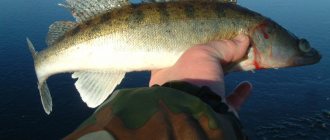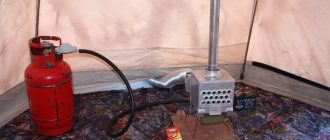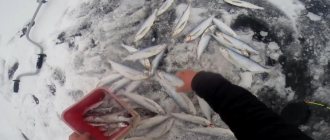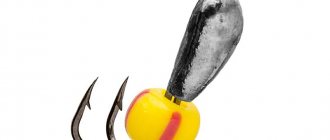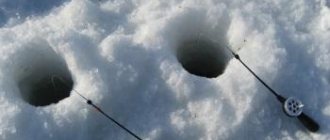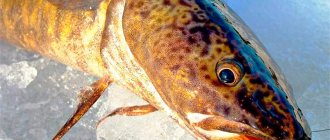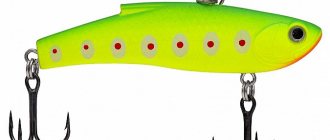Wobblers for ice fishing
A vertical wobbler for winter fishing is a bait that imitates a weakened or wounded fish. This device allows you to attract the attention of predatory inhabitants of reservoirs.
Did you know? The largest freshwater fish was caught in 1983 in California (USA). It was a sturgeon weighing 212.28 kg.
This type of equipment is also called rattlin or vib. The first name is a Russian slang word among fishermen. It comes from the popular at one time name for wobblers “Rapala Rattlin”. This particular tackle was the first, and for a long time, the only one of its kind. The second name comes from the word “vibration”.
Initially, rattlins were invented for the purpose of being used only for winter fishing with vertical lures. A little later, the bait was reclassified as an all-season bait and even began to be used primarily in the summer.
Wobblers are not formed into a common subgroup, as is the case with minnows, jerks, and cranks. However, they differ in a number of characteristic features, which makes it possible to use them for ice fishing, and with great success.
Main characteristics
Fishing in winter is carried out through small holes, which does not allow spinning anglers to fully make horizontal movements. The main feature of the wobbler is the organized, lively or inactive play of the bait when it is held vertically. This method is based on the fact that the bait is immersed in the water column in a free position. Accordingly, the second characteristic feature of the tackle is its ability to sink.
Also find out which shelf is best for winter fishing.
Based on this, there are 2 groups of wobblers:
- quickly sinking - weigh 7–8 g or more;
- slowly sinking - have a mass of less than 7 g.
Winter wobblers also differ in the way they are attached to gear. If summer variations are fixed in the head part, then those intended for ice fishing are fixed in the dorsal section. This is what allows, when the bait is immersed, to produce a high-frequency game with a small amplitude of vibrations, which stimulates predators to attack.
Did you know? If the bite is sluggish, you can provoke the fish to attack by hanging a hook wrapped in red thread from the spoon.
In addition to the above, rattlins are characterized by the following features:
- blade devices on the bait are completely absent;
- there are 2 hooks (tees) - one each in the center and at the back in the lower part;
- Inside the bait there are always special balls that provide a sound effect.
Wiring a wobbler for pike
As a rule, when fishing for pike, the most effective is a slow and steady retrieve. If the bait is fished in the bottom layer, then in order for it to swim longer, it is necessary to lower the tip of the rod close to the surface of the water.
When we fish in shallow water, we should move the bait with stops, slowly turning the reel handle. At such moments, a predator's attack often follows. After capture, you need to change your location. When fishing on the surface, you should choose baits that look as natural as possible. That is, they look like dace, roach or perch. The pike has such a specific vision that it sees very well all objects moving on the surface of the reservoir.
It is very important to move the wobbler to the pike at a certain pace; at the same time, you can evenly twitch the tip of the rod. In calm areas it is better to use a light rod with a flexible tip. The casts will not be long, so you can use a slow action rod. It happens that during the day a pike attacks the bait with a medium retrieve with periodic jerks, and after a few hours it only takes a simple, uniform retrieve at an average speed. And on some fishing trips you can simply throw a popper or walker and not even do any retrieving, but just wait a minute or two, after which the attack follows. You can catch several specimens this way.
The same thing happens with baits. Sometimes you get the impression that two or three suitcases of bait are not enough. But this is a mistaken opinion. If you have several boxes of pike kits, then they may be enough for a wave. The main thing is to remember which of them was the best for pike on previous fishing trips at the same time. And in order not to forget, it is better to keep a notebook in which to write down which baits and in what periods the pike took better, with a note of what kind of wiring took place.
If we fish at a depth of 6-7 meters, then a floating wobbler is driven evenly among the vegetation. Sometimes you can pause, allowing the bait to float to a certain depth. At such moments, the predator often attacks.
Separately, it is necessary to say about wiring when fishing in dense vegetation. The point of fishing in such conditions comes down to the fact that we need to find windows between the grass or water lilies and throw into them. It would be nice to have a boat in such situations. Then the casting range will be several meters. If there is no boat, then this is not bad, since the fisherman is constantly improving his throwing technique and strives to hit a small spot. Why do you need to throw specifically at these windows? Everything is very simple: small and large fish stay in these zones. And the fishermen who catch crucian carp and rudd there know this very well.
It is best to use floating wobblers. They will make such a game that the pike will not be able to resist. There were even cases when the fisherman missed and delivered the wobbler directly to the water lily. I waited a little, and the pike, without hesitation, took this wobbler off the rack like a suffering glass of beer.
However, with an average and not very good bite, a number of operations should be performed that should be crowned with success. After casting the bait, you need to wait 8-10 seconds. We need the wobbler to go a meter deep, no more. We select just such a floating wobbler. Next, make 2-3 turns with the coil. During this wiring, the wobbler will nod off. You can make a different wiring of the wobbler for pike. When the wobbler gets into the water, we perform a sharp reeling of 4-5 turns and pause and wait 2-3 seconds for the bait to float up. At such moments, the pike can take it. Then we repeat all the operations again.
In addition to poppers, wobblers with one hook and an anti-hook mechanism are suitable in such places.
When fishing from the bottom, as mentioned above, a stepped retrieve, similar to jigging, is more suitable. After casting the bait, the reel is reeled in with a sharp penetration to the bottom.
Advantages and disadvantages of wobblers for winter fishing
Like any fishing device, wobblers have a number of advantages and disadvantages. This information is very important for those who want to choose the ideal tackle for specific fishing conditions.
- The main advantages of rattlins:
- some models can yaw like balance beams;
- ensuring high catchability;
- stable vertical play;
- a wide variety of models designed for different fishing conditions.
- Among the disadvantages are:
- quite high cost;
- frequent hooks, especially when fishing from the shore.
The first drawback, if we consider the quantity and quality of the catch, will be almost invisible. The second disadvantage can be easily corrected by replacing treble hooks with double ones.
Equipment
Fishing with rattlins does not require the use of special equipment. The standard is perfect for winter glitter. The grip on such a bait is strong and can be easily felt by the hand. It is better to use equipment more carefully. This will allow you to more clearly feel the wiring with your hands. The fishing line should be taken with a diameter of 0.2–0.35 mm, as usual, guided by the approximate size of the intended trophy.
Important! If you go fishing for pike, do not forget that you need a metal leash, because it can easily damage any other one.
This type of bait can be attached like a balancer to a blind loop. The quality of the vibration game depends on the weight and dimensions of the hooks. If desired and necessary, you can change them to those that will be more convenient. You shouldn’t go overboard with placing additional bright elements on them, but a small fish eye or cambric on the central hook won’t hurt.
The wobbler is also secured through a swivel. This makes it possible to protect the line from twisting and ensure free movement of the bait.
Top 10 wobblers for pike fishing
Fishing stores offer many models of such lures, so it can be difficult for a novice fisherman to make a choice. To simplify the purchase, you should evaluate the Top 10 wobblers for pike fishing from the site na-rybalke.ru. Enjoy watching.
Tenth place - Yo-Zuri L Minnow 66
The wobbler is small in size and works well in the spring, when fish do not respond well to artificial baits. The bait can be used at great depths in areas with strong currents. Cost – from 450 rubles.
Ninth place – Jackall Squad Minnow 80 SP
The suspender is suitable for all fans of twitching fishing. With a length of 82 mm, the bait weighs 9.7 grams and quickly sinks to a depth of 0.8-1.2 meters, maintaining a given position throughout the entire wiring process.
The cost of the bait is from 850 rubles according to Yandex Market.
Eighth place - Lucky Craft Pointer 100 SP
The eighth position in the ranking is occupied by the Lucky Craft Pointer 100 SP wobbler. Its advantage is its versatility, so the bait is effective in any reservoir where pike are found. The length of the model is 100 mm and the weight is 18 grams. For wiring, it is recommended to use twitching equipment.
While moving in the water, the design creates a characteristic sound that attracts fish from great distances. Even if the angler stops turning the reel handle, the Pointer continues to exhibit oscillation.
It is usually used at a depth of 1.5-2 meters. The model is sold at a price of 800 rubles.
Seventh place Salmo Perch 140 SDR
The length of the wobbler is 140 mm, which makes it suitable for searching for large pike. A large selection of bait colors is available for sale, but for toothy predators it is better to use silver models, which are clearly visible in shallow water, because reflect rays of light. The cost of a wobbler starts from 980 rubles.
Sixth place - Jackall SQUAD MINNOW 95
The SQUAD MINNOW 95 wobbler is characterized by its small size, but is not inferior in efficiency to previous large models. This bait combines all the advantages of minnow and shad class wobblers, which makes it a good tool for searching for toothy predators in deep waters.
The design is equipped with two treble hooks, while the likelihood of snagging on snags and vegetation is minimal. The cost of the model starts from 1050 rubles.
Fifth place - Owner Cultiva Rip'n Minnow 112 SP
The model belongs to the class of heavy suspended wobblers, with the help of which it is possible to catch large pike. The body length is 112 mm, and the weight is 21 g. The depth of penetration is one and a half meters. The use of a good balancing system allows the bait to fly over long distances and hit exactly the specified location.
Two Owner ST-46 treble hooks are attached to the structure, which have a sharp fore-end and virtually eliminate the possibility of fish falling off the hook. The product performs at its best with twitching and uniform wiring.
Buying a wobbler will cost 350-450 rubles.
Fourth place - Zipbaits Khamsin 70SR
The model is characterized by neutral buoyancy and belongs to the group of suspenders. With its help, you can catch pike in shallow water areas or near thickets of underwater vegetation, where the toothy predator often ambushes.
In appearance, the wobbler looks like a small crucian carp with a tungsten weight, which provides a good casting range and excellent balancing of the bait in the water. There are two suspender lengths available on the market: 50 and 70 mm. Their weight varies from 4 to 9.5 g, respectively.
The bait is equipped with a small submersible blade and is designed to work at a depth of 0.5 to 1.5 m. Maximum performance is observed when using “stop and go” wiring and uniform twitching. The product is equipped with three tees and is sold at a price of 800 rubles.
Third place - ORBIT 110SP
The ORBIT 110SP wobbler is produced by the famous Japanese company Zipbaits and belongs to the class of suspenders. A distinctive feature of the model is its elongated profile, reminiscent of a roach or bleak. When immersed in water, the product can hang for a long time in one horizon. To reveal all its capabilities, it is necessary to use jerk wiring.
The good flight range is due to the presence of a magnetic balancer, which improves aerodynamic properties and acts as a loading system.
Using the ORBIT 110SP wobbler, you can effectively explore remote water areas that are difficult to reach with other bait. The body of the bait contains three sharp hooks that reliably pierce the fish’s jaw, eliminating any chance of failure. The cost of the product is about 1200 rubles.
Second place - Ima Flit 120
Second place in the rating belongs to the IMA Flit 120 bait. Weighing 14 grams, it can be used for catching large pike by trolling. The product is characterized by an average amplitude of movements during wiring, which makes it effective in luring a predator onto the path.
The color options and game specifics closely resemble real loot. This increases the chances of a good bite even with passive fish behavior. The wobbler size is 120 mm and the weight is 14 g.
IMA Flit 120SP is considered one of the most popular spinning wobblers for fans of fishing with “big minnow” class baits.
The correct design with well-chosen aerodynamic properties, an internal balancing system and optimal weight guarantee a high casting distance.
Fishermen claim that the bait reveals all its advantages when using twitching wiring. The immersion depth with this technique is 1.5-2 meters. If you use uniform wiring with periodic accelerations, it increases to three meters.
The cost of the model is about 900 rubles.
First place - OSP RUDRA
For more than ten years, Japanese Rudra wobblers have been very popular among anglers. They belong to the minnow class and are 130 mm long. In Japan, the model was used for catching large bass, and when it appeared on the domestic market, it began to be used when hunting large predators, especially pike and pike perch. Today, the wobbler occupies a leading position in the ranking of the best amateur and professional baits.
A distinctive feature of the model is its well-chosen design, which implies the presence of a balancing system with a low center of gravity. This makes it responsive to manipulation and attractive even with slow retrieval. The wobbler performs well with low fish activity.
The specifics of the game are based on a combination of turning the product left and right and yawing around. The joint movements form the characteristic “Rudra signature”.
There are several wobbler models available for sale with varying degrees of buoyancy. There are suspender, neutral, floating, sinking and slowly floating models.
The classic model RUDRA SP, 130 mm long and weighing 20 grams, is effective in areas with abundant vegetation and a depth of up to two meters. It sells for around 1,400 rubles.
Winter fishing technique
To get good results using a vib, you must use the correct fishing technique. It is not particularly difficult, but it is not similar to standard spinning or balancing game. Having bought a new bait, the first thing you should do is test it at home or using an underwater camera. The main wiring of the winter bait of this type is based on tossing and pausing, as well as vibration and jig fishing.
We recommend reading about how to make homemade jigs for winter fishing.
For perch
For perches, take the smallest and lightest baits, since fishing is often carried out almost near the coastline or at shallow depths. It is better to match the color of the bait to match the object of the hunt. To further attract the attention of a predator, beads or small pieces of wool should be attached to the hooks. Perch tends to react actively to a variety of active shaking.
For zander
Pike perch are hunted at great depths. It is better to use heavy models with a length of 7 cm or more to catch it. Slowness, vibration and circulation are important to attract this predator.
Did you know? The record for the longest cast of a tackle belongs to Walter Kummerow. In 1984, he was able to throw equipment weighing 30 kg over a distance of 175 m.
Wiring for zander:
- Standard toss and release with a pause.
- Small tremors at the bottom.
- A smooth rise of 10–15 cm and a slow descent.
For pike
For this predator, take the largest models of winter vibes. There is no specific technique specifically for pike. Everything is achieved only through experience. Important factors that will help achieve good results will be information about the landscape of a particular reservoir and the habits of the predator in different winter periods.
For trout
For trout, as for perch, small-sized baits are used. The length of the tackle for catching this fish should be 5–7 cm. To catch prey, you will need the ability to jerk. Less commonly, a stepwise vibration technique is required.
Wobbler under the ice on the current
Why not try the same thing, but in the current, especially since this method simplifies the search for fish. So we thought and went to the big river not far from the city.
And the result was not long in coming. Pike, grayling and chub responded to this unusual bait for winter. And the fishing technique is quite simple. An ordinary spinning rod of short length (180-240 cm), an inertia-free reel with fishing line (the cord does not like frost and friction against the edge of the hole) and a wobbler, depending on the depth at the fishing site. We drill a hole at an angle to the ice surface (approximately 45 degrees) in the direction of the flow. If the wobbler is sinking, then we simply lower it into the hole, and it sinks itself, and if the bait is floating, then we reel the wobbler up to the tulip, lower the spinning rod under the ice and the current itself picks up the bait, all you have to do is open the line brace. Next, we slowly release the wobbler, periodically retrieving the spinning rod towards ourselves. When the release is sufficient (depending on the fishing location), we begin reeling in the bait.
You can release the bait at least a hundred meters, as long as the depth does not change much during this run - keep in mind that once you hook the bait to the bottom, you won’t be able to swim up and unhook it, as in the summer. Remember that the slower the current, the higher your wobbler will go when released. Bites can happen both when releasing the bait and when reeling in, and with a large number of bites, moving against the current is more effective, and when there is little fish activity, on the contrary, moving towards the drift is more effective.
We used this fishing method at two depths - 1-1.5 meters and 3-4 meters. In the first case, we came across grayling and chubs, and in the second - pike, perch and the same grayling. In shallow water, the Excalibur UL Ghost Minnow 5.7 cm wobbler with a perch color worked well, in the shallows with a slow current - a Rebel Minnow 4.5 cm wobbler with color 82 (perch), and at depth the best were a small Magnum with a blue back (pike) and Wally Diver in clown color from Cotton Cordell (perch and large grayling).
It is likely that other predators, such as pike perch, can be caught this way. In any case, in one trip we fish a much larger area than with standard winter trolling.
But I would like to immediately reassure those of you who rush headlong into the rivers to fish using this method - the catchability of this technique is lower (at least for me) than when fishing with girders, winter stands and other inactive methods of fishing. The whole “buzz” of this fishing is its activity with the presence of some effectiveness.
How are they different from summer
Vibes for winter fishing differ from summer ones in the position of the center of gravity. In a free suspension, they are in a horizontal position, while analogues for catching the inhabitants of reservoirs in the warm season are with the tail down. In the water column, winter wobblers are in a vertical position, and summer ones are in a horizontal position. In addition, vibrations for fishing in the cold season are high-frequency baits that stimulate aggression and the desire to attack in predators.
Important! When choosing a wobbler, be sure to take into account the transparency of the water. In muddy conditions you will need brighter baits, in light ones, on the contrary, less noticeable ones.
Recently, wobblers have been one of the most popular types of bait for winter fishing. They are distinguished by good maneuverability and high oscillation frequency, which makes it easy to provoke a predatory fish to attack and hook it.
Foam fish for pike
For details on making homemade foam fish, see our article at the link.
There are other lures similar to wobblers, but without blades - jerkbaits. Jerkbaits are large, sinking, heavy-weight lures that are used to catch trophy pike.
Jerkbaits also have their own classification; read more about these baits in the article “Fishing with jerkbaits.”
Another interesting bait is a swimbait, not to be confused with a stickbait.
A swimbait is a multi-component solid bait that ideally follows the movements of a fish with a uniform retrieve.
It is considered one of the most effective baits, but its cost is very high.
